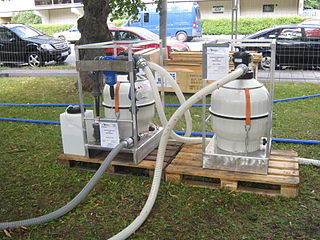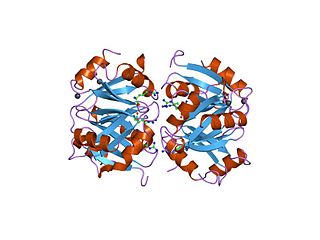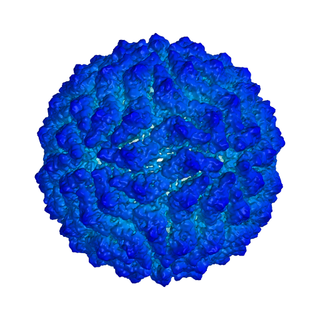
Giardia is a genus of anaerobic flagellated protozoan parasites of the phylum Metamonada that colonise and reproduce in the small intestines of several vertebrates, causing the disease giardiasis. Their life cycle alternates between a swimming trophozoite and an infective, resistant cyst. Giardia were first described by the Dutch microscopist Antonie van Leeuwenhoek in 1681. The genus is named after French zoologist Alfred Mathieu Giard.

Giardia duodenalis, also known as Giardia intestinalis and Giardia lamblia, is a flagellated parasitic microorganism of the genus Giardia that colonizes the small intestine, causing a diarrheal condition known as giardiasis. The parasite attaches to the epithelium by a ventral adhesive disc or sucker, and reproduces via binary fission. Giardiasis does not spread via the bloodstream, nor does it spread to other parts of the gastrointestinal tract, but remains confined to the lumen of the small intestine. Giardia has an outer membrane that makes it possible to retain life, even when outside of the host body, and which can make it tolerant to chlorine disinfection. Giardia trophozoites absorb their nutrients from the lumen, and are anaerobes. If the organism is split and stained, its characteristic pattern resembles the familiar "smiley face" symbol.

Giardiasis is a parasitic disease caused by Giardia duodenalis. Infected individuals who experience symptoms may have diarrhea, abdominal pain, and weight loss. Less common symptoms include vomiting and blood in the stool. Symptoms usually begin 1 to 3 weeks after exposure and, without treatment, may last two to six weeks or longer.

Trichomonas vaginalis is an anaerobic, flagellated protozoan parasite and the causative agent of a sexually transmitted disease called trichomoniasis. It is the most common pathogenic protozoan that infects humans in industrialized countries. Infection rates in men and women are similar but women are usually symptomatic, while infections in men are usually asymptomatic. Transmission usually occurs via direct, skin-to-skin contact with an infected individual, most often through vaginal intercourse. The WHO has estimated that 160 million cases of infection are acquired annually worldwide. The estimates for North America alone are between 5 and 8 million new infections each year, with an estimated rate of asymptomatic cases as high as 50%. Usually treatment consists of metronidazole and tinidazole.

The diplomonads are a group of flagellates, most of which are parasitic. They include Giardia duodenalis, which causes giardiasis in humans. They are placed among the metamonads, and appear to be particularly close relatives of the retortamonads.

Totiviridae is a family of double-stranded RNA viruses. Giardia lamblia, leishmania, trichomonas vaginalis, and fungi serve as natural hosts. The name of the group derives from Latin toti which means undivided or whole. There are 28 species in this family, assigned to 5 genera.

Furazolidone is a nitrofuran antibacterial agent and monoamine oxidase inhibitor (MAOI). It is marketed by Roberts Laboratories under the brand name Furoxone and by GlaxoSmithKline as Dependal-M.
Wilderness-acquired diarrhea is a variety of traveler's diarrhea in which backpackers and other outdoor enthusiasts are affected. Potential sources are contaminated food or water, or "hand-to-mouth", directly from another person who is infected. Cases generally resolve spontaneously, with or without treatment, and the cause is typically unknown. The National Outdoor Leadership School has recorded about one incident per 5,000 person-field days by following strict protocols on hygiene and water treatment. More limited, separate studies have presented highly varied estimated rates of affliction that range from 3 percent to 74 percent of wilderness visitors. One survey found that long-distance Appalachian Trail hikers reported diarrhea as their most common illness. Based on reviews of epidemiologic data and literature, some researchers believe that the risks have been over-stated and are poorly understood by the public.
Enterocolitis is an inflammation of the digestive tract, involving enteritis of the small intestine and colitis of the colon. It may be caused by various infections, with bacteria, viruses, fungi, parasites, or other causes. Common clinical manifestations of enterocolitis are frequent diarrheal defecations, with or without nausea, vomiting, abdominal pain, fever, chills, alteration of general condition. General manifestations are given by the dissemination of the infectious agent or its toxins throughout the body, or – most frequently – by significant losses of water and minerals, the consequence of diarrhea and vomiting.

Portable water purification devices are self-contained, easily transported units used to purify water from untreated sources for drinking purposes. Their main function is to eliminate pathogens, and often also of suspended solids and some unpalatable or toxic compounds.
Antiparasitics are a class of medications which are indicated for the treatment of parasitic diseases, such as those caused by helminths, amoeba, ectoparasites, parasitic fungi, and protozoa, among others. Antiparasitics target the parasitic agents of the infections by destroying them or inhibiting their growth; they are usually effective against a limited number of parasites within a particular class. Antiparasitics are one of the antimicrobial drugs which include antibiotics that target bacteria, and antifungals that target fungi. They may be administered orally, intravenously or topically. Overuse or misuse of antiparasitics can lead to the development of antimicrobial resistance.

Vilém Dušan Lambl was a Czech physician. He authored his medical publications, which were in German, as Wilhelm Lambl.

Alfred Mathieu Giard was a French zoologist born in Valenciennes.

Howard Ensign Evans was an American entomologist who was a specialist on wasps. He was also the author of several popular works on entomology including Life on a Little-known Planet (1978), The Pleasures of Entomology (1985) and Wasp Farm (1963).
The discovery of disease-causing pathogens is an important activity in the field of medical science. Many viruses, bacteria, protozoa, fungi, helminthes and prions are identified as a confirmed or potential pathogen. In the United States, a Centers for Disease Control program, begun in 1995, identified over a hundred patients with life-threatening illnesses that were considered to be of an infectious cause, but that could not be linked to a known pathogen. The association of pathogens with disease can be a complex and controversial process, in some cases requiring decades or even centuries to achieve.
Chilomastix mesnili is a non-pathogenic member of primate gastrointestinal microflora, commonly associated with but not causing parasitic infections. It is found in about 3.5% of the population in the United States. In addition to humans, Chilomastix is found in chimpanzees, orangutans, monkeys, and pigs. It lives in the cecum and colon. C. mesnili has a similar life style to Giardia lamblia.

Svartediket is a lake in the city of Bergen in Vestland county, Norway. The 0.5-square-kilometre (0.19 sq mi) lake lies immediately north of the mountain Ulriken, northeast of the Store Lungegårdsvannet bay. Historically, this lake was called Ålrekstadsvannet, but in the late 19th century, a dam was built on the south end of the lake to create a reservoir for the city's drinking water. The lake is the main source of drinking water for the central parts of the city of Bergen. There is a pumping station and treatment facility build adjacent to the lake inside the mountain Ulriken. Drinking water is collected at a 28-metre (92 ft) depth in Svartediket. Inside the water treatment plant, the water is filtered and irradiated with UV light to kill harmful microorganisms. After treatment, the clean drinking water is stored in a 15,000-cubic-metre (530,000 cu ft) large water pool inside the mountain. This is the water that is pumped down to the city center for drinking water. In 2004, Bergen was hit by a Giardia lamblia epidemic which had its source in the lake Svartediket. The water treatment facility was upgraded in 2007.

In molecular biology, the arginine repressor (ArgR) is a repressor of prokaryotic arginine deiminase pathways.
In molecular biology, small nucleolar RNA derived microRNAs are microRNAs (miRNA) derived from small nucleolar RNA (snoRNA). MicroRNAs are usually derived from precursors known as pre-miRNAs, these pre-miRNAs are recognised and cleaved from a pri-miRNA precursor by the Pasha and Drosha proteins. However some microRNAs, mirtrons, are known to be derived from introns via a different pathway which bypasses Pasha and Drosha. Some microRNAs are also known to be derived from small nucleolar RNA.

Giardiavirus is a genus of viruses, in the family Totiviridae. Protozoa serve as natural hosts. There is only one species in this genus: Giardia lamblia virus.












